Role of Nurse in Patient Education on Hypertension
VerifiedAdded on 2022/12/05
|8
|2782
|203
AI Summary
This literature review discusses the role of nurses in patient education on hypertension, focusing on the importance of nursing care for older people with hypertension. It explores nursing diagnoses and care planning goals for hypertension patients, including risk for decreased cardiac output, activity intolerance, acute pain, ineffective coping, imbalanced nutrition, and deficient knowledge. The review emphasizes the need for better care and improved health outcomes for older patients with hypertension.
Contribute Materials
Your contribution can guide someone’s learning journey. Share your
documents today.
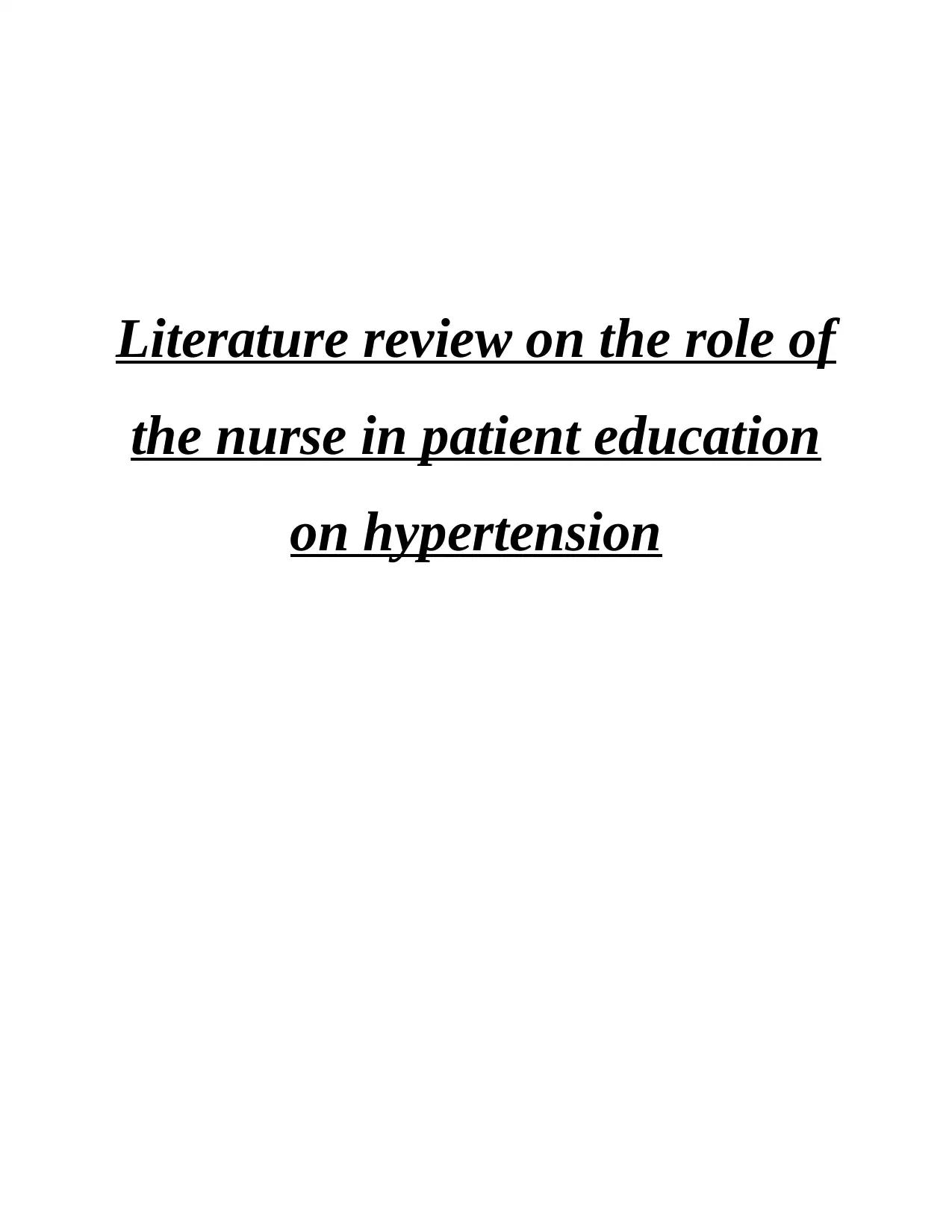
Literature review on the role of
the nurse in patient education
on hypertension
the nurse in patient education
on hypertension
Secure Best Marks with AI Grader
Need help grading? Try our AI Grader for instant feedback on your assignments.
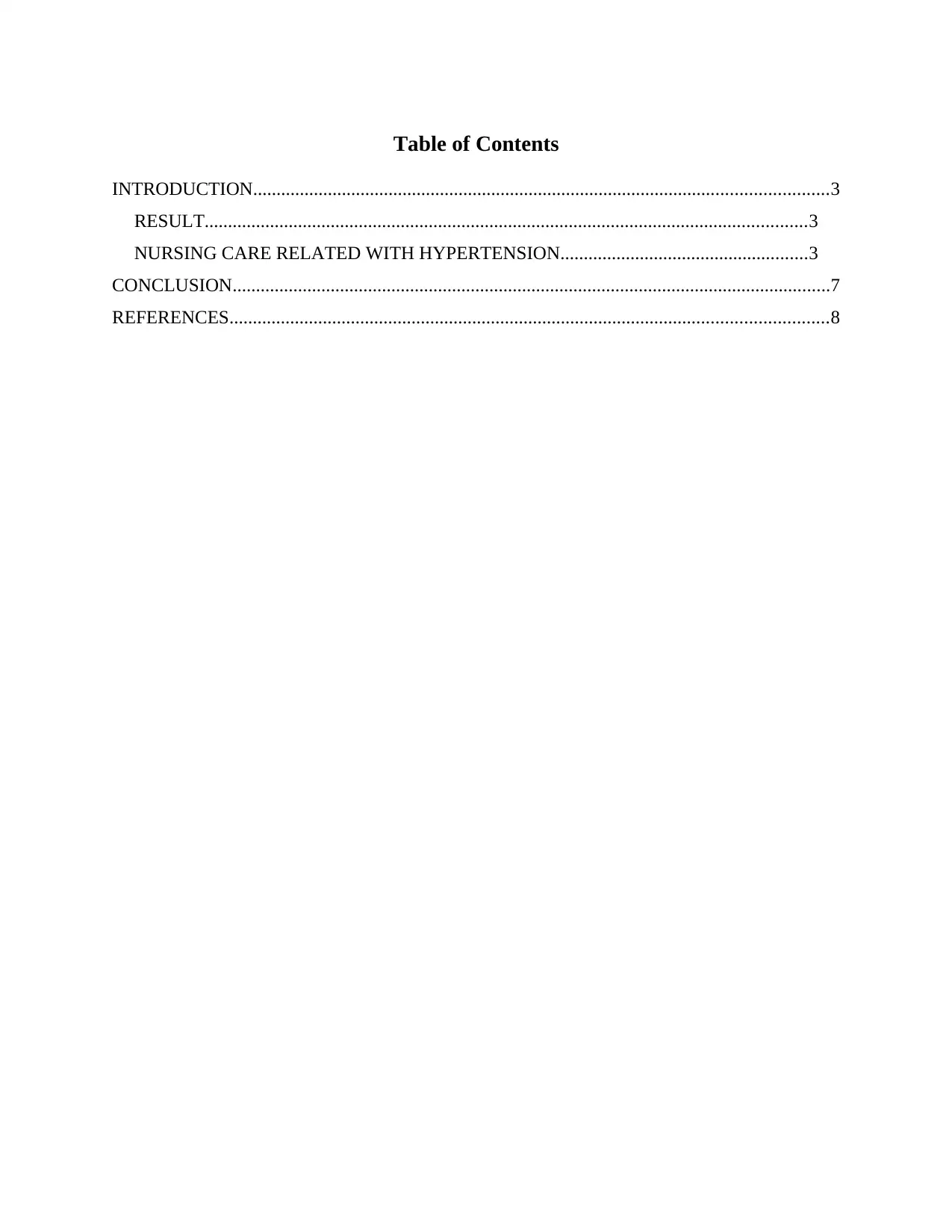
Table of Contents
INTRODUCTION...........................................................................................................................3
RESULT.................................................................................................................................3
NURSING CARE RELATED WITH HYPERTENSION.....................................................3
CONCLUSION................................................................................................................................7
REFERENCES................................................................................................................................8
INTRODUCTION...........................................................................................................................3
RESULT.................................................................................................................................3
NURSING CARE RELATED WITH HYPERTENSION.....................................................3
CONCLUSION................................................................................................................................7
REFERENCES................................................................................................................................8
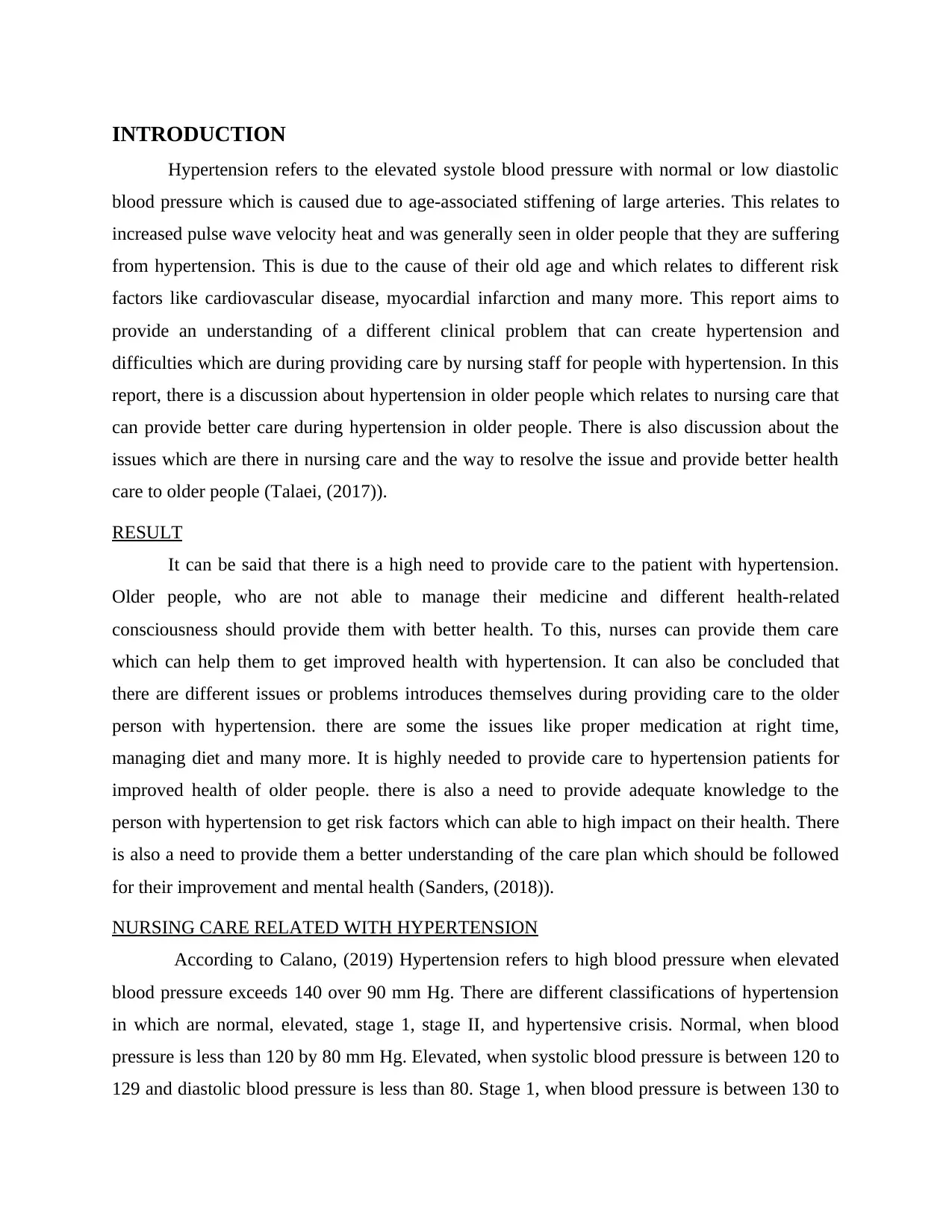
INTRODUCTION
Hypertension refers to the elevated systole blood pressure with normal or low diastolic
blood pressure which is caused due to age-associated stiffening of large arteries. This relates to
increased pulse wave velocity heat and was generally seen in older people that they are suffering
from hypertension. This is due to the cause of their old age and which relates to different risk
factors like cardiovascular disease, myocardial infarction and many more. This report aims to
provide an understanding of a different clinical problem that can create hypertension and
difficulties which are during providing care by nursing staff for people with hypertension. In this
report, there is a discussion about hypertension in older people which relates to nursing care that
can provide better care during hypertension in older people. There is also discussion about the
issues which are there in nursing care and the way to resolve the issue and provide better health
care to older people (Talaei, (2017)).
RESULT
It can be said that there is a high need to provide care to the patient with hypertension.
Older people, who are not able to manage their medicine and different health-related
consciousness should provide them with better health. To this, nurses can provide them care
which can help them to get improved health with hypertension. It can also be concluded that
there are different issues or problems introduces themselves during providing care to the older
person with hypertension. there are some the issues like proper medication at right time,
managing diet and many more. It is highly needed to provide care to hypertension patients for
improved health of older people. there is also a need to provide adequate knowledge to the
person with hypertension to get risk factors which can able to high impact on their health. There
is also a need to provide them a better understanding of the care plan which should be followed
for their improvement and mental health (Sanders, (2018)).
NURSING CARE RELATED WITH HYPERTENSION
According to Calano, (2019) Hypertension refers to high blood pressure when elevated
blood pressure exceeds 140 over 90 mm Hg. There are different classifications of hypertension
in which are normal, elevated, stage 1, stage II, and hypertensive crisis. Normal, when blood
pressure is less than 120 by 80 mm Hg. Elevated, when systolic blood pressure is between 120 to
129 and diastolic blood pressure is less than 80. Stage 1, when blood pressure is between 130 to
Hypertension refers to the elevated systole blood pressure with normal or low diastolic
blood pressure which is caused due to age-associated stiffening of large arteries. This relates to
increased pulse wave velocity heat and was generally seen in older people that they are suffering
from hypertension. This is due to the cause of their old age and which relates to different risk
factors like cardiovascular disease, myocardial infarction and many more. This report aims to
provide an understanding of a different clinical problem that can create hypertension and
difficulties which are during providing care by nursing staff for people with hypertension. In this
report, there is a discussion about hypertension in older people which relates to nursing care that
can provide better care during hypertension in older people. There is also discussion about the
issues which are there in nursing care and the way to resolve the issue and provide better health
care to older people (Talaei, (2017)).
RESULT
It can be said that there is a high need to provide care to the patient with hypertension.
Older people, who are not able to manage their medicine and different health-related
consciousness should provide them with better health. To this, nurses can provide them care
which can help them to get improved health with hypertension. It can also be concluded that
there are different issues or problems introduces themselves during providing care to the older
person with hypertension. there are some the issues like proper medication at right time,
managing diet and many more. It is highly needed to provide care to hypertension patients for
improved health of older people. there is also a need to provide adequate knowledge to the
person with hypertension to get risk factors which can able to high impact on their health. There
is also a need to provide them a better understanding of the care plan which should be followed
for their improvement and mental health (Sanders, (2018)).
NURSING CARE RELATED WITH HYPERTENSION
According to Calano, (2019) Hypertension refers to high blood pressure when elevated
blood pressure exceeds 140 over 90 mm Hg. There are different classifications of hypertension
in which are normal, elevated, stage 1, stage II, and hypertensive crisis. Normal, when blood
pressure is less than 120 by 80 mm Hg. Elevated, when systolic blood pressure is between 120 to
129 and diastolic blood pressure is less than 80. Stage 1, when blood pressure is between 130 to
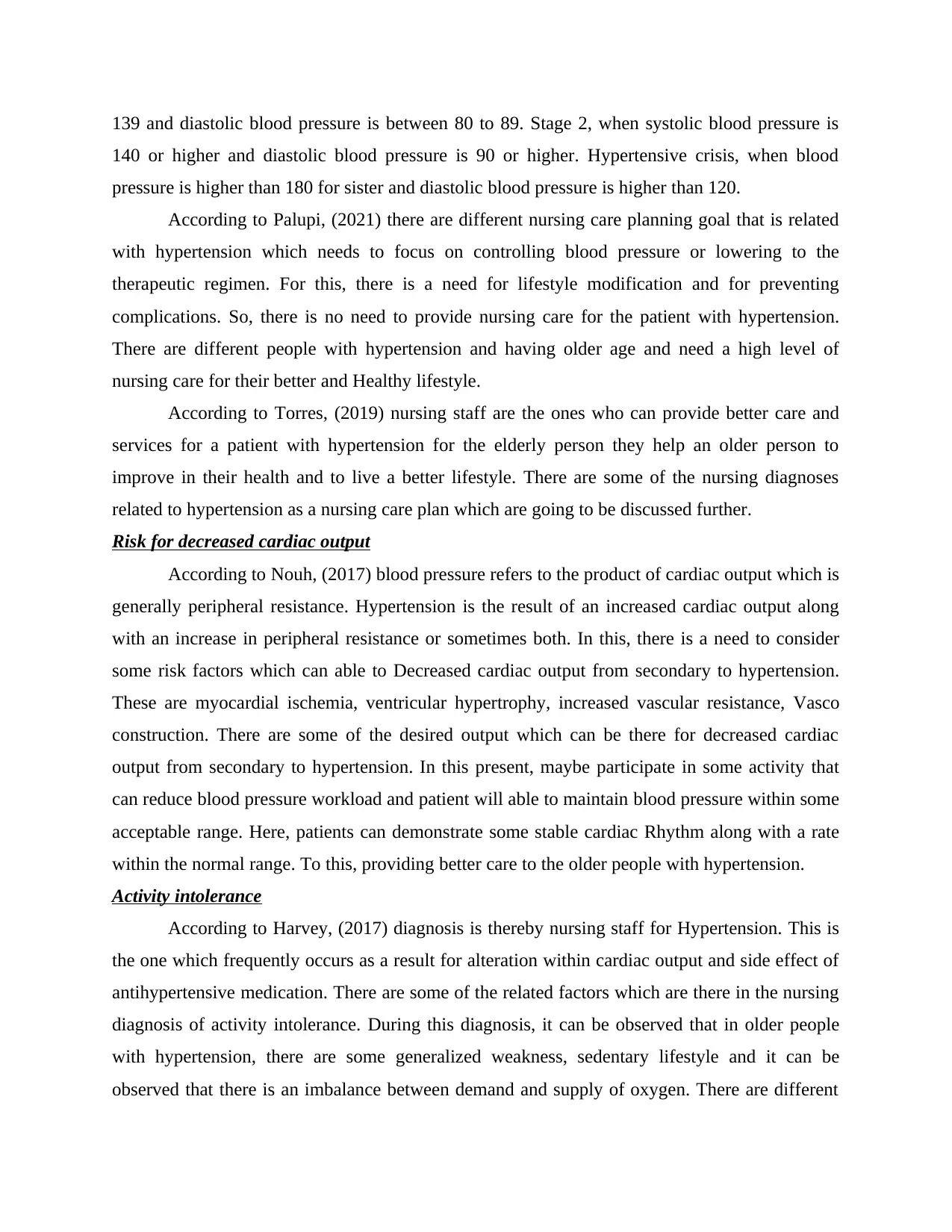
139 and diastolic blood pressure is between 80 to 89. Stage 2, when systolic blood pressure is
140 or higher and diastolic blood pressure is 90 or higher. Hypertensive crisis, when blood
pressure is higher than 180 for sister and diastolic blood pressure is higher than 120.
According to Palupi, (2021) there are different nursing care planning goal that is related
with hypertension which needs to focus on controlling blood pressure or lowering to the
therapeutic regimen. For this, there is a need for lifestyle modification and for preventing
complications. So, there is no need to provide nursing care for the patient with hypertension.
There are different people with hypertension and having older age and need a high level of
nursing care for their better and Healthy lifestyle.
According to Torres, (2019) nursing staff are the ones who can provide better care and
services for a patient with hypertension for the elderly person they help an older person to
improve in their health and to live a better lifestyle. There are some of the nursing diagnoses
related to hypertension as a nursing care plan which are going to be discussed further.
Risk for decreased cardiac output
According to Nouh, (2017) blood pressure refers to the product of cardiac output which is
generally peripheral resistance. Hypertension is the result of an increased cardiac output along
with an increase in peripheral resistance or sometimes both. In this, there is a need to consider
some risk factors which can able to Decreased cardiac output from secondary to hypertension.
These are myocardial ischemia, ventricular hypertrophy, increased vascular resistance, Vasco
construction. There are some of the desired output which can be there for decreased cardiac
output from secondary to hypertension. In this present, maybe participate in some activity that
can reduce blood pressure workload and patient will able to maintain blood pressure within some
acceptable range. Here, patients can demonstrate some stable cardiac Rhythm along with a rate
within the normal range. To this, providing better care to the older people with hypertension.
Activity intolerance
According to Harvey, (2017) diagnosis is thereby nursing staff for Hypertension. This is
the one which frequently occurs as a result for alteration within cardiac output and side effect of
antihypertensive medication. There are some of the related factors which are there in the nursing
diagnosis of activity intolerance. During this diagnosis, it can be observed that in older people
with hypertension, there are some generalized weakness, sedentary lifestyle and it can be
observed that there is an imbalance between demand and supply of oxygen. There are different
140 or higher and diastolic blood pressure is 90 or higher. Hypertensive crisis, when blood
pressure is higher than 180 for sister and diastolic blood pressure is higher than 120.
According to Palupi, (2021) there are different nursing care planning goal that is related
with hypertension which needs to focus on controlling blood pressure or lowering to the
therapeutic regimen. For this, there is a need for lifestyle modification and for preventing
complications. So, there is no need to provide nursing care for the patient with hypertension.
There are different people with hypertension and having older age and need a high level of
nursing care for their better and Healthy lifestyle.
According to Torres, (2019) nursing staff are the ones who can provide better care and
services for a patient with hypertension for the elderly person they help an older person to
improve in their health and to live a better lifestyle. There are some of the nursing diagnoses
related to hypertension as a nursing care plan which are going to be discussed further.
Risk for decreased cardiac output
According to Nouh, (2017) blood pressure refers to the product of cardiac output which is
generally peripheral resistance. Hypertension is the result of an increased cardiac output along
with an increase in peripheral resistance or sometimes both. In this, there is a need to consider
some risk factors which can able to Decreased cardiac output from secondary to hypertension.
These are myocardial ischemia, ventricular hypertrophy, increased vascular resistance, Vasco
construction. There are some of the desired output which can be there for decreased cardiac
output from secondary to hypertension. In this present, maybe participate in some activity that
can reduce blood pressure workload and patient will able to maintain blood pressure within some
acceptable range. Here, patients can demonstrate some stable cardiac Rhythm along with a rate
within the normal range. To this, providing better care to the older people with hypertension.
Activity intolerance
According to Harvey, (2017) diagnosis is thereby nursing staff for Hypertension. This is
the one which frequently occurs as a result for alteration within cardiac output and side effect of
antihypertensive medication. There are some of the related factors which are there in the nursing
diagnosis of activity intolerance. During this diagnosis, it can be observed that in older people
with hypertension, there are some generalized weakness, sedentary lifestyle and it can be
observed that there is an imbalance between demand and supply of oxygen. There are different
Secure Best Marks with AI Grader
Need help grading? Try our AI Grader for instant feedback on your assignments.
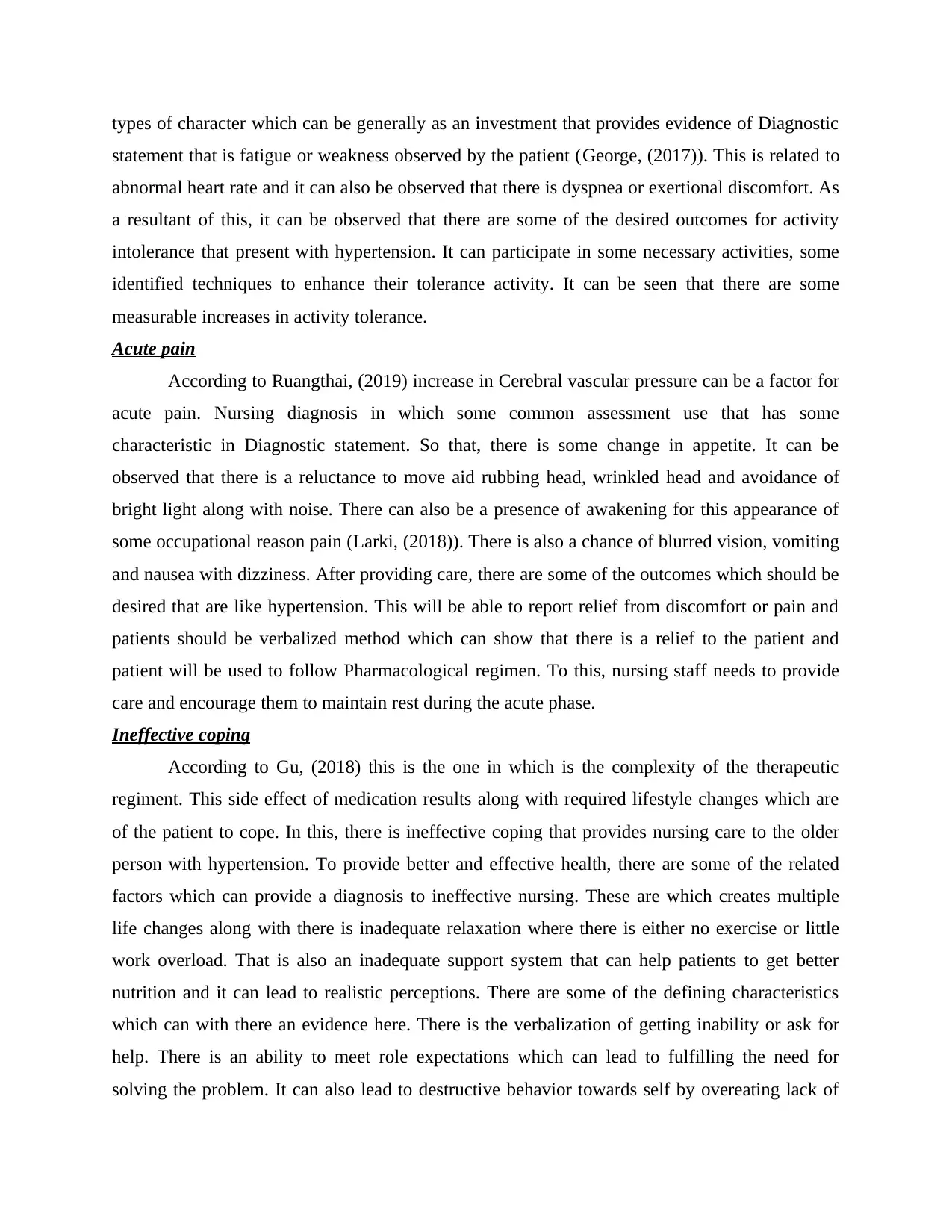
types of character which can be generally as an investment that provides evidence of Diagnostic
statement that is fatigue or weakness observed by the patient (George, (2017)). This is related to
abnormal heart rate and it can also be observed that there is dyspnea or exertional discomfort. As
a resultant of this, it can be observed that there are some of the desired outcomes for activity
intolerance that present with hypertension. It can participate in some necessary activities, some
identified techniques to enhance their tolerance activity. It can be seen that there are some
measurable increases in activity tolerance.
Acute pain
According to Ruangthai, (2019) increase in Cerebral vascular pressure can be a factor for
acute pain. Nursing diagnosis in which some common assessment use that has some
characteristic in Diagnostic statement. So that, there is some change in appetite. It can be
observed that there is a reluctance to move aid rubbing head, wrinkled head and avoidance of
bright light along with noise. There can also be a presence of awakening for this appearance of
some occupational reason pain (Larki, (2018)). There is also a chance of blurred vision, vomiting
and nausea with dizziness. After providing care, there are some of the outcomes which should be
desired that are like hypertension. This will be able to report relief from discomfort or pain and
patients should be verbalized method which can show that there is a relief to the patient and
patient will be used to follow Pharmacological regimen. To this, nursing staff needs to provide
care and encourage them to maintain rest during the acute phase.
Ineffective coping
According to Gu, (2018) this is the one in which is the complexity of the therapeutic
regiment. This side effect of medication results along with required lifestyle changes which are
of the patient to cope. In this, there is ineffective coping that provides nursing care to the older
person with hypertension. To provide better and effective health, there are some of the related
factors which can provide a diagnosis to ineffective nursing. These are which creates multiple
life changes along with there is inadequate relaxation where there is either no exercise or little
work overload. That is also an inadequate support system that can help patients to get better
nutrition and it can lead to realistic perceptions. There are some of the defining characteristics
which can with there an evidence here. There is the verbalization of getting inability or ask for
help. There is an ability to meet role expectations which can lead to fulfilling the need for
solving the problem. It can also lead to destructive behavior towards self by overeating lack of
statement that is fatigue or weakness observed by the patient (George, (2017)). This is related to
abnormal heart rate and it can also be observed that there is dyspnea or exertional discomfort. As
a resultant of this, it can be observed that there are some of the desired outcomes for activity
intolerance that present with hypertension. It can participate in some necessary activities, some
identified techniques to enhance their tolerance activity. It can be seen that there are some
measurable increases in activity tolerance.
Acute pain
According to Ruangthai, (2019) increase in Cerebral vascular pressure can be a factor for
acute pain. Nursing diagnosis in which some common assessment use that has some
characteristic in Diagnostic statement. So that, there is some change in appetite. It can be
observed that there is a reluctance to move aid rubbing head, wrinkled head and avoidance of
bright light along with noise. There can also be a presence of awakening for this appearance of
some occupational reason pain (Larki, (2018)). There is also a chance of blurred vision, vomiting
and nausea with dizziness. After providing care, there are some of the outcomes which should be
desired that are like hypertension. This will be able to report relief from discomfort or pain and
patients should be verbalized method which can show that there is a relief to the patient and
patient will be used to follow Pharmacological regimen. To this, nursing staff needs to provide
care and encourage them to maintain rest during the acute phase.
Ineffective coping
According to Gu, (2018) this is the one in which is the complexity of the therapeutic
regiment. This side effect of medication results along with required lifestyle changes which are
of the patient to cope. In this, there is ineffective coping that provides nursing care to the older
person with hypertension. To provide better and effective health, there are some of the related
factors which can provide a diagnosis to ineffective nursing. These are which creates multiple
life changes along with there is inadequate relaxation where there is either no exercise or little
work overload. That is also an inadequate support system that can help patients to get better
nutrition and it can lead to realistic perceptions. There are some of the defining characteristics
which can with there an evidence here. There is the verbalization of getting inability or ask for
help. There is an ability to meet role expectations which can lead to fulfilling the need for
solving the problem. It can also lead to destructive behavior towards self by overeating lack of
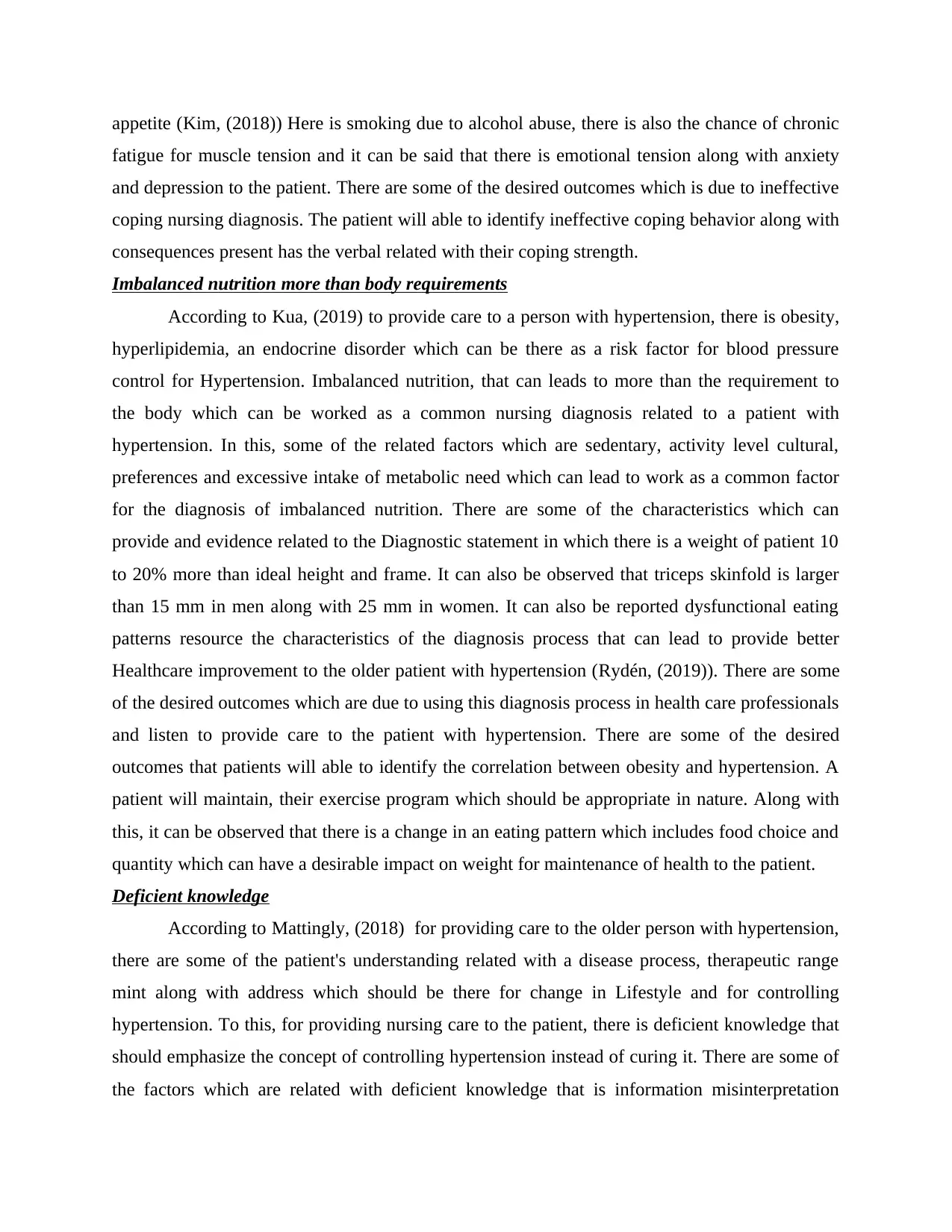
appetite (Kim, (2018)) Here is smoking due to alcohol abuse, there is also the chance of chronic
fatigue for muscle tension and it can be said that there is emotional tension along with anxiety
and depression to the patient. There are some of the desired outcomes which is due to ineffective
coping nursing diagnosis. The patient will able to identify ineffective coping behavior along with
consequences present has the verbal related with their coping strength.
Imbalanced nutrition more than body requirements
According to Kua, (2019) to provide care to a person with hypertension, there is obesity,
hyperlipidemia, an endocrine disorder which can be there as a risk factor for blood pressure
control for Hypertension. Imbalanced nutrition, that can leads to more than the requirement to
the body which can be worked as a common nursing diagnosis related to a patient with
hypertension. In this, some of the related factors which are sedentary, activity level cultural,
preferences and excessive intake of metabolic need which can lead to work as a common factor
for the diagnosis of imbalanced nutrition. There are some of the characteristics which can
provide and evidence related to the Diagnostic statement in which there is a weight of patient 10
to 20% more than ideal height and frame. It can also be observed that triceps skinfold is larger
than 15 mm in men along with 25 mm in women. It can also be reported dysfunctional eating
patterns resource the characteristics of the diagnosis process that can lead to provide better
Healthcare improvement to the older patient with hypertension (Rydén, (2019)). There are some
of the desired outcomes which are due to using this diagnosis process in health care professionals
and listen to provide care to the patient with hypertension. There are some of the desired
outcomes that patients will able to identify the correlation between obesity and hypertension. A
patient will maintain, their exercise program which should be appropriate in nature. Along with
this, it can be observed that there is a change in an eating pattern which includes food choice and
quantity which can have a desirable impact on weight for maintenance of health to the patient.
Deficient knowledge
According to Mattingly, (2018) for providing care to the older person with hypertension,
there are some of the patient's understanding related with a disease process, therapeutic range
mint along with address which should be there for change in Lifestyle and for controlling
hypertension. To this, for providing nursing care to the patient, there is deficient knowledge that
should emphasize the concept of controlling hypertension instead of curing it. There are some of
the factors which are related with deficient knowledge that is information misinterpretation
fatigue for muscle tension and it can be said that there is emotional tension along with anxiety
and depression to the patient. There are some of the desired outcomes which is due to ineffective
coping nursing diagnosis. The patient will able to identify ineffective coping behavior along with
consequences present has the verbal related with their coping strength.
Imbalanced nutrition more than body requirements
According to Kua, (2019) to provide care to a person with hypertension, there is obesity,
hyperlipidemia, an endocrine disorder which can be there as a risk factor for blood pressure
control for Hypertension. Imbalanced nutrition, that can leads to more than the requirement to
the body which can be worked as a common nursing diagnosis related to a patient with
hypertension. In this, some of the related factors which are sedentary, activity level cultural,
preferences and excessive intake of metabolic need which can lead to work as a common factor
for the diagnosis of imbalanced nutrition. There are some of the characteristics which can
provide and evidence related to the Diagnostic statement in which there is a weight of patient 10
to 20% more than ideal height and frame. It can also be observed that triceps skinfold is larger
than 15 mm in men along with 25 mm in women. It can also be reported dysfunctional eating
patterns resource the characteristics of the diagnosis process that can lead to provide better
Healthcare improvement to the older patient with hypertension (Rydén, (2019)). There are some
of the desired outcomes which are due to using this diagnosis process in health care professionals
and listen to provide care to the patient with hypertension. There are some of the desired
outcomes that patients will able to identify the correlation between obesity and hypertension. A
patient will maintain, their exercise program which should be appropriate in nature. Along with
this, it can be observed that there is a change in an eating pattern which includes food choice and
quantity which can have a desirable impact on weight for maintenance of health to the patient.
Deficient knowledge
According to Mattingly, (2018) for providing care to the older person with hypertension,
there are some of the patient's understanding related with a disease process, therapeutic range
mint along with address which should be there for change in Lifestyle and for controlling
hypertension. To this, for providing nursing care to the patient, there is deficient knowledge that
should emphasize the concept of controlling hypertension instead of curing it. There are some of
the factors which are related with deficient knowledge that is information misinterpretation
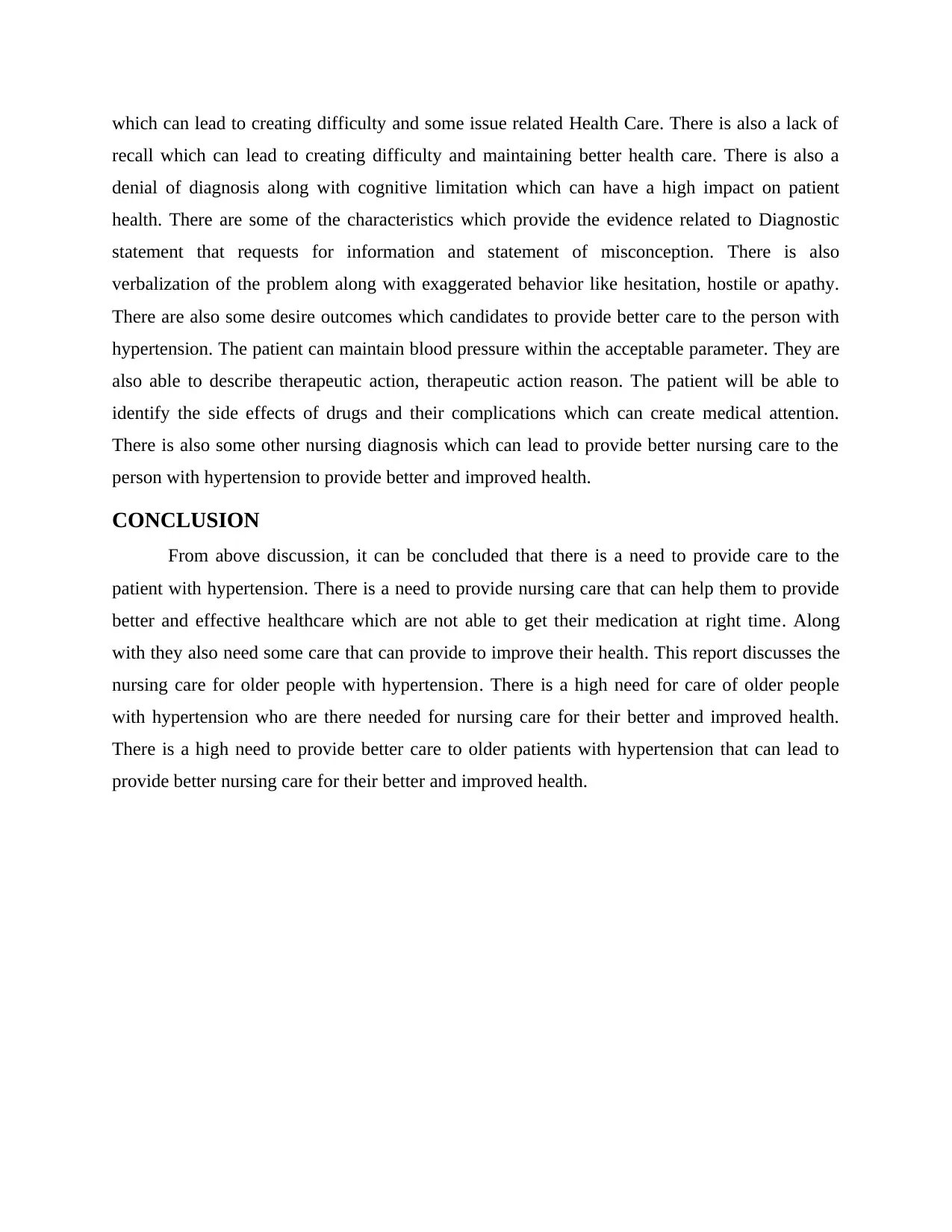
which can lead to creating difficulty and some issue related Health Care. There is also a lack of
recall which can lead to creating difficulty and maintaining better health care. There is also a
denial of diagnosis along with cognitive limitation which can have a high impact on patient
health. There are some of the characteristics which provide the evidence related to Diagnostic
statement that requests for information and statement of misconception. There is also
verbalization of the problem along with exaggerated behavior like hesitation, hostile or apathy.
There are also some desire outcomes which candidates to provide better care to the person with
hypertension. The patient can maintain blood pressure within the acceptable parameter. They are
also able to describe therapeutic action, therapeutic action reason. The patient will be able to
identify the side effects of drugs and their complications which can create medical attention.
There is also some other nursing diagnosis which can lead to provide better nursing care to the
person with hypertension to provide better and improved health.
CONCLUSION
From above discussion, it can be concluded that there is a need to provide care to the
patient with hypertension. There is a need to provide nursing care that can help them to provide
better and effective healthcare which are not able to get their medication at right time. Along
with they also need some care that can provide to improve their health. This report discusses the
nursing care for older people with hypertension. There is a high need for care of older people
with hypertension who are there needed for nursing care for their better and improved health.
There is a high need to provide better care to older patients with hypertension that can lead to
provide better nursing care for their better and improved health.
recall which can lead to creating difficulty and maintaining better health care. There is also a
denial of diagnosis along with cognitive limitation which can have a high impact on patient
health. There are some of the characteristics which provide the evidence related to Diagnostic
statement that requests for information and statement of misconception. There is also
verbalization of the problem along with exaggerated behavior like hesitation, hostile or apathy.
There are also some desire outcomes which candidates to provide better care to the person with
hypertension. The patient can maintain blood pressure within the acceptable parameter. They are
also able to describe therapeutic action, therapeutic action reason. The patient will be able to
identify the side effects of drugs and their complications which can create medical attention.
There is also some other nursing diagnosis which can lead to provide better nursing care to the
person with hypertension to provide better and improved health.
CONCLUSION
From above discussion, it can be concluded that there is a need to provide care to the
patient with hypertension. There is a need to provide nursing care that can help them to provide
better and effective healthcare which are not able to get their medication at right time. Along
with they also need some care that can provide to improve their health. This report discusses the
nursing care for older people with hypertension. There is a high need for care of older people
with hypertension who are there needed for nursing care for their better and improved health.
There is a high need to provide better care to older patients with hypertension that can lead to
provide better nursing care for their better and improved health.
Paraphrase This Document
Need a fresh take? Get an instant paraphrase of this document with our AI Paraphraser
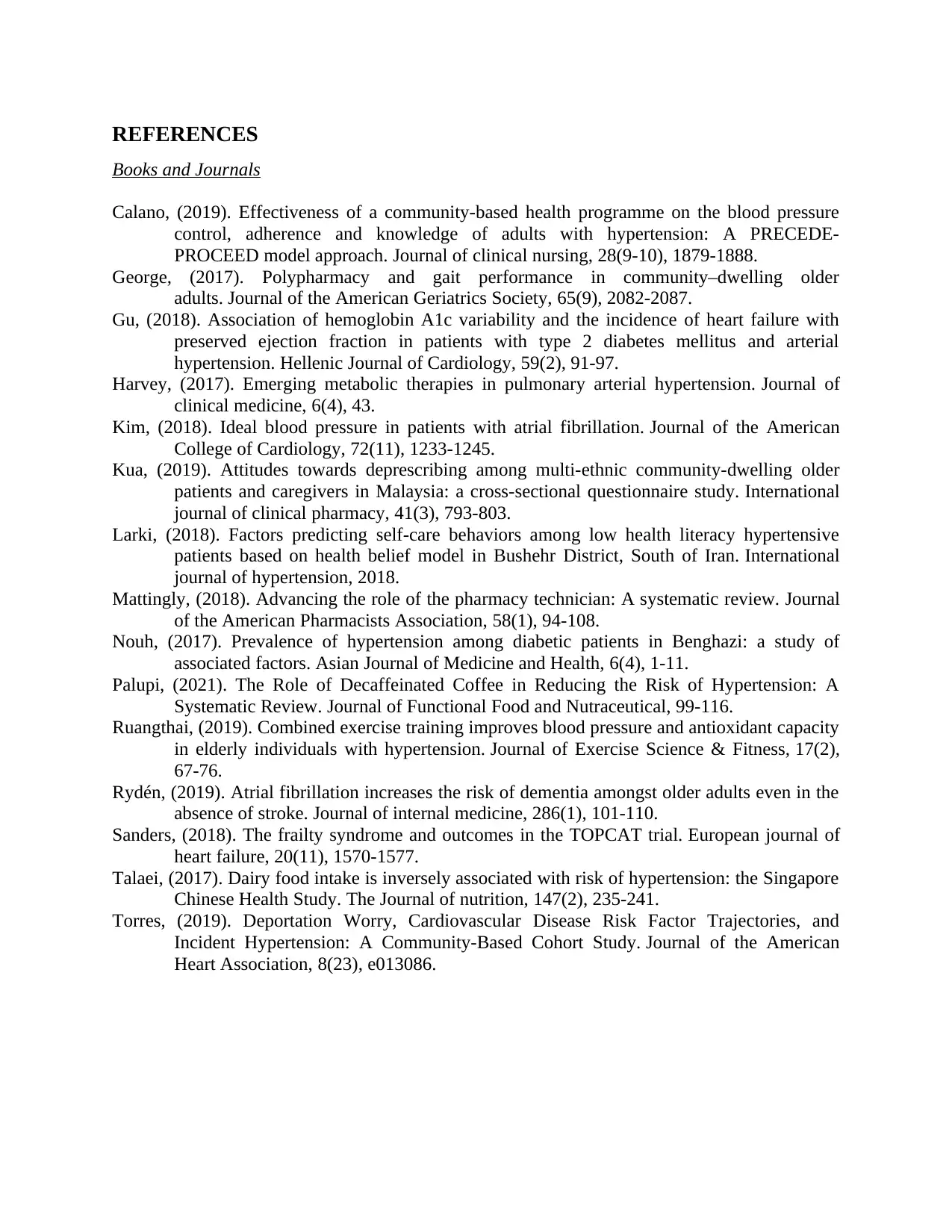
REFERENCES
Books and Journals
Calano, (2019). Effectiveness of a community‐based health programme on the blood pressure
control, adherence and knowledge of adults with hypertension: A PRECEDE‐
PROCEED model approach. Journal of clinical nursing, 28(9-10), 1879-1888.
George, (2017). Polypharmacy and gait performance in community–dwelling older
adults. Journal of the American Geriatrics Society, 65(9), 2082-2087.
Gu, (2018). Association of hemoglobin A1c variability and the incidence of heart failure with
preserved ejection fraction in patients with type 2 diabetes mellitus and arterial
hypertension. Hellenic Journal of Cardiology, 59(2), 91-97.
Harvey, (2017). Emerging metabolic therapies in pulmonary arterial hypertension. Journal of
clinical medicine, 6(4), 43.
Kim, (2018). Ideal blood pressure in patients with atrial fibrillation. Journal of the American
College of Cardiology, 72(11), 1233-1245.
Kua, (2019). Attitudes towards deprescribing among multi-ethnic community-dwelling older
patients and caregivers in Malaysia: a cross-sectional questionnaire study. International
journal of clinical pharmacy, 41(3), 793-803.
Larki, (2018). Factors predicting self-care behaviors among low health literacy hypertensive
patients based on health belief model in Bushehr District, South of Iran. International
journal of hypertension, 2018.
Mattingly, (2018). Advancing the role of the pharmacy technician: A systematic review. Journal
of the American Pharmacists Association, 58(1), 94-108.
Nouh, (2017). Prevalence of hypertension among diabetic patients in Benghazi: a study of
associated factors. Asian Journal of Medicine and Health, 6(4), 1-11.
Palupi, (2021). The Role of Decaffeinated Coffee in Reducing the Risk of Hypertension: A
Systematic Review. Journal of Functional Food and Nutraceutical, 99-116.
Ruangthai, (2019). Combined exercise training improves blood pressure and antioxidant capacity
in elderly individuals with hypertension. Journal of Exercise Science & Fitness, 17(2),
67-76.
Rydén, (2019). Atrial fibrillation increases the risk of dementia amongst older adults even in the
absence of stroke. Journal of internal medicine, 286(1), 101-110.
Sanders, (2018). The frailty syndrome and outcomes in the TOPCAT trial. European journal of
heart failure, 20(11), 1570-1577.
Talaei, (2017). Dairy food intake is inversely associated with risk of hypertension: the Singapore
Chinese Health Study. The Journal of nutrition, 147(2), 235-241.
Torres, (2019). Deportation Worry, Cardiovascular Disease Risk Factor Trajectories, and
Incident Hypertension: A Community‐Based Cohort Study. Journal of the American
Heart Association, 8(23), e013086.
Books and Journals
Calano, (2019). Effectiveness of a community‐based health programme on the blood pressure
control, adherence and knowledge of adults with hypertension: A PRECEDE‐
PROCEED model approach. Journal of clinical nursing, 28(9-10), 1879-1888.
George, (2017). Polypharmacy and gait performance in community–dwelling older
adults. Journal of the American Geriatrics Society, 65(9), 2082-2087.
Gu, (2018). Association of hemoglobin A1c variability and the incidence of heart failure with
preserved ejection fraction in patients with type 2 diabetes mellitus and arterial
hypertension. Hellenic Journal of Cardiology, 59(2), 91-97.
Harvey, (2017). Emerging metabolic therapies in pulmonary arterial hypertension. Journal of
clinical medicine, 6(4), 43.
Kim, (2018). Ideal blood pressure in patients with atrial fibrillation. Journal of the American
College of Cardiology, 72(11), 1233-1245.
Kua, (2019). Attitudes towards deprescribing among multi-ethnic community-dwelling older
patients and caregivers in Malaysia: a cross-sectional questionnaire study. International
journal of clinical pharmacy, 41(3), 793-803.
Larki, (2018). Factors predicting self-care behaviors among low health literacy hypertensive
patients based on health belief model in Bushehr District, South of Iran. International
journal of hypertension, 2018.
Mattingly, (2018). Advancing the role of the pharmacy technician: A systematic review. Journal
of the American Pharmacists Association, 58(1), 94-108.
Nouh, (2017). Prevalence of hypertension among diabetic patients in Benghazi: a study of
associated factors. Asian Journal of Medicine and Health, 6(4), 1-11.
Palupi, (2021). The Role of Decaffeinated Coffee in Reducing the Risk of Hypertension: A
Systematic Review. Journal of Functional Food and Nutraceutical, 99-116.
Ruangthai, (2019). Combined exercise training improves blood pressure and antioxidant capacity
in elderly individuals with hypertension. Journal of Exercise Science & Fitness, 17(2),
67-76.
Rydén, (2019). Atrial fibrillation increases the risk of dementia amongst older adults even in the
absence of stroke. Journal of internal medicine, 286(1), 101-110.
Sanders, (2018). The frailty syndrome and outcomes in the TOPCAT trial. European journal of
heart failure, 20(11), 1570-1577.
Talaei, (2017). Dairy food intake is inversely associated with risk of hypertension: the Singapore
Chinese Health Study. The Journal of nutrition, 147(2), 235-241.
Torres, (2019). Deportation Worry, Cardiovascular Disease Risk Factor Trajectories, and
Incident Hypertension: A Community‐Based Cohort Study. Journal of the American
Heart Association, 8(23), e013086.
1 out of 8
Related Documents
Your All-in-One AI-Powered Toolkit for Academic Success.
+13062052269
info@desklib.com
Available 24*7 on WhatsApp / Email
![[object Object]](/_next/static/media/star-bottom.7253800d.svg)
Unlock your academic potential
© 2024 | Zucol Services PVT LTD | All rights reserved.





